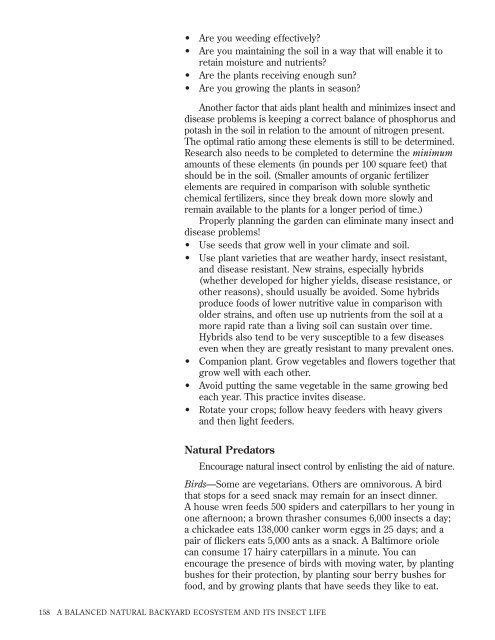How to Grow More Vegetables : And Fruits, Nuts ... - Shroomery
How to Grow More Vegetables : And Fruits, Nuts ... - Shroomery
How to Grow More Vegetables : And Fruits, Nuts ... - Shroomery
Create successful ePaper yourself
Turn your PDF publications into a flip-book with our unique Google optimized e-Paper software.
• Are you weeding effectively?<br />
• Are you maintaining the soil in a way that will enable it <strong>to</strong><br />
retain moisture and nutrients?<br />
• Are the plants receiving enough sun?<br />
• Are you growing the plants in season?<br />
Another fac<strong>to</strong>r that aids plant health and minimizes insect and<br />
disease problems is keeping a correct balance of phosphorus and<br />
potash in the soil in relation <strong>to</strong> the amount of nitrogen present.<br />
The optimal ratio among these elements is still <strong>to</strong> be determined.<br />
Research also needs <strong>to</strong> be completed <strong>to</strong> determine the minimum<br />
amounts of these elements (in pounds per 100 square feet) that<br />
should be in the soil. (Smaller amounts of organic fertilizer<br />
elements are required in comparison with soluble synthetic<br />
chemical fertilizers, since they break down more slowly and<br />
remain available <strong>to</strong> the plants for a longer period of time.)<br />
Properly planning the garden can eliminate many insect and<br />
disease problems!<br />
• Use seeds that grow well in your climate and soil.<br />
• Use plant varieties that are weather hardy, insect resistant,<br />
and disease resistant. New strains, especially hybrids<br />
(whether developed for higher yields, disease resistance, or<br />
other reasons), should usually be avoided. Some hybrids<br />
produce foods of lower nutritive value in comparison with<br />
older strains, and often use up nutrients from the soil at a<br />
more rapid rate than a living soil can sustain over time.<br />
Hybrids also tend <strong>to</strong> be very susceptible <strong>to</strong> a few diseases<br />
even when they are greatly resistant <strong>to</strong> many prevalent ones.<br />
• Companion plant. <strong>Grow</strong> vegetables and flowers <strong>to</strong>gether that<br />
grow well with each other.<br />
• Avoid putting the same vegetable in the same growing bed<br />
each year. This practice invites disease.<br />
• Rotate your crops; follow heavy feeders with heavy givers<br />
and then light feeders.<br />
Natural Preda<strong>to</strong>rs<br />
Encourage natural insect control by enlisting the aid of nature.<br />
Birds—Some are vegetarians. Others are omnivorous. A bird<br />
that s<strong>to</strong>ps for a seed snack may remain for an insect dinner.<br />
A house wren feeds 500 spiders and caterpillars <strong>to</strong> her young in<br />
one afternoon; a brown thrasher consumes 6,000 insects a day;<br />
a chickadee eats 138,000 canker worm eggs in 25 days; and a<br />
pair of flickers eats 5,000 ants as a snack. A Baltimore oriole<br />
can consume 17 hairy caterpillars in a minute. You can<br />
encourage the presence of birds with moving water, by planting<br />
bushes for their protection, by planting sour berry bushes for<br />
food, and by growing plants that have seeds they like <strong>to</strong> eat.<br />
158 A BALANCED NATURAL BACKYARD ECOSYSTEM AND ITS INSECT LIFE












